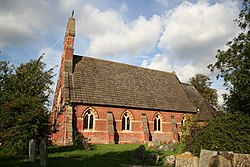Hoveringham
| Hoveringham | |
| Nottinghamshire | |
|---|---|
 St Michael's Church, Hoveringham | |
| Location | |
| Grid reference: | SK699466 |
| Location: | 53°-0’46"N, 0°57’34"W |
| Data | |
| Population: | 359 (2011) |
| Post town: | Nottingham |
| Postcode: | NG14 |
| Local Government | |
| Council: | Newark and Sherwood |
| Parliamentary constituency: |
Newark |
Hoveringham is a small village in Nottinghamshire about ten miles north-east of Nottingham and on the west side of the River Trent, upstream of Newark on Trent. The village stands just off the A612 trunk road to Southwell. The population of the civil parish as taken at the 2011 Census was 359. The adjacent area has extensive sand and gravel deposits which have been quarried there for many years.
Parish church
The parish church, St Michael's, is of mediaeval origin, but it was largely rebuilt in 1865 under the architectural direction of William Knight of Nottingham.[1]
The church contains a 12th-century tympanum from the earlier structure. It is a Grade II listed building.[2]
Hoveringham today is in a joint parish with St Mary's Church, Bleasby; St James' Church, Halloughton and the Priory Church of St Peter, Thurgarton.
An organ was installed in June 1891 and replaced in the early 1970s by an organ from elsewhere installed by Henry Groves & Son. A specification of the organ can be found on the National Pipe Organ Register.[3]
History
Hoveringham is recorded in the 1086 Domesday Book as a manor in the county's Thurgarton Wapentake.[4] The manor and lands had been, in the 13th century and later, in the possession of the Gousehill family, Sir Richard Gousehill, who was slain at the Battle of Shrewsbury 21 July 1403, being then Lord of the Manor of Hoveringham.[5]
White's Directory of Nottinghamshire in 1853 says:
"Near the village there was once a ferry across the Trent to Kneeton. In the reign on Henry III it was possessed by Hugh de Hoveringham, and afterwards passed to the Goushill family, by whom a great part of the estate was given to Thurgarton Priory, from which it passed to Trinity College, Cambridge, which has since received other lands in lieu of the tithes. This parish was tithe free for upwards of 70 years until 1851, when four shillings per acre was laid on as tithe, but it is the opinion of all the freeholders that it is not legal. In 1795, many old writings and documents which were deposited in the church were destroyed by the great flood. It is supposed that the writings belonging to the land which was set apart in lieu of the tithes were amongst them. Sir Richard Sutton, Bart., is lessee of the manorial rights, and of 647 acres of college land, which was held by the Cooper family, from the time of the Reformation till 1830. There are about 20 freeholders in the parish. The church is a small, ancient structure, dedicated to St. Michael, and is in the patronage of the same college. It is a perpetual curacy, was valued at £60, and is annexed to that of Thurgarton."[6]
Gravel
Gravel extraction was started in this area in 1939 by the Hoveringham Gravel company, which was taken over in 1982 by Tarmac. The Hoveringham Gravel Company used to have a mammoth as their logo on their lorries as a celebration of the finding of mammoth remains in their workings.
Sport
Hoveringham Cricket Club was founded before 1803 and is one of the oldest clubs in Nottinghamshire.
Outside links
| ("Wikimedia Commons" has material about Hoveringham) |
- Example of the exposed mudstones, sand and gravel deposits of the Trent valley
- Hoveringham Parish Council
- Ferry Farm Park, Hoveringham
- Hoveringham Cricket Club
References
- ↑ Nikolaus Pevsner: The Buildings of England: Nottinghamshire, 1951; 1979 Penguin Books ISBN 978-0-300-09636-1
- ↑ National Heritage List : Church of St Michael, Hoveringham (Grade II listing)
- ↑ St Michael, Hoveringham: The National Pipe Organ Register
- ↑ Hoveringham in the Domesday Book
- ↑ Richardson, Douglas, Magna Carta Ancestry, Baltimore, Md., 2007, pps:338 & 771, ISBN 0-8063-1759-0
- ↑ Information on Hoveringham from GENUKI
